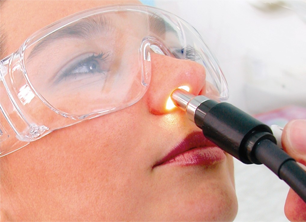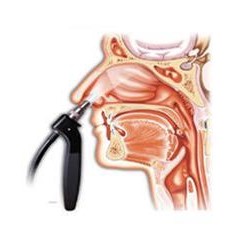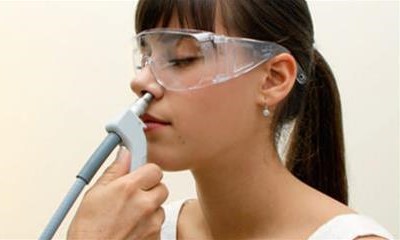
Rhinolight
Endonasal phototherapy for nose and sinus allergy
Rhinolight intra-nasal U/V phototherapy is a very effective non-pharmacological treatment option for both allergic rhinitis and non-allergic rhinitis. Rhinolight is used in short courses with the benefits lasting for months or years.
What is Rhinolight?
For decades phototherapy has been used in hospital settings to treat skin conditions such as psoriasis and atopic dermatitis (eczema). The inflammatory effects that occur in eczematous skin are similar to those that occur in the nasal mucosa following exposure to inhalant allergens such as house dust mite and grass pollen. Therefore, over 20 years ago U/V phototherapy was adapted for use within the nasal passages.
Endonasal phototherapy uses a specific narrow range of UV-A and UV-B light to treat the inflammation and tissue swelling that occurs within the nose due to recurrent allergic challenge. This is considered a safe range of U/V light for medical therapy and causes neither heat nor pain on the treated surface. Phototherapy reduces the allergic reactivity of the nasal mucosa to all inhalant allergens and therefore results in reduced nasal congestion and sneezing. It may also help restore the sense of smell when swelling of the nasal mucosa has compressed the Olfactory nerve. Reducing nasal inflammation may also help reduce the development of allergically driven nasal polyps.
Pathophysiological Basis
Allergic inflammation in the nose is characterised by the influx of immune cells such as Th2 lymphocytes, eosinophils and mast cells. These cells migrate to the nasal mucosa when its surfaces are exposed to the culprit allergen. They are not required for normal nasal function. On arrival in the nasal tissues, the activated immune cells then secrete inflammatory mediators such as Interleukin 4, 5 and 13 as well as prostaglandins, kinins, leukotrienes and histamine. This results in swollen irritated nasal mucosa and produces the characteristic symptoms of Allergic Rhinitis.
Therefore, targeting these migratory immune cells with endonasal phototherapy significantly curtails the inflammatory response to inhalant allergens while restoring the nasal mucosa to normal function. Since this form of immune response evolved primarily to defend against parasitic infections, which have been eradicated in the developed world, inhibiting this response is known to be safe.
Rhinolight Efficacy
For the vast majority of patients, Rhinolight significantly reduces their nasal symptoms and often allows them to reduce their reliance on medications for symptom control. Please note that while Rhinolight is usually highly effective, it is not a 'once off' cure.
During early studies of endonasal phototherapy both standard anti-allergy medications and phototherapy were combined. As patient symptoms significantly improved it was decided to use Rhinolight alone. There was as much patient satisfaction with Rhinolight alone as with the combination of Rhinolight and anti-allergy medications. Rhinolight was found to be effective in treating both allergic rhinitis and non-allergic rhinitis. Indeed, Rhinolight phototherapy is effective for allergic rhinitis regardless of the allergic trigger e.g. pollen, house dust mite and animal hair.
Based on the patients who have completed Rhinolight at Allergy Ireland:
- Rhinolight therapy success rate is around 95%.
- Therefore, it does not work for everyone.
- Not all of the 90% above had total symptom clearance but all of them did feel an improvement following the treatment.
- Some patients felt relief within their first 3 sessions. Most experienced symptom relief only after reaching sessions 6-8 (or session 10 in several severe cases). It takes up to 3 weeks following treatment to feel the full benefits.
- Patients may experience a mild exacerbation of their nasal symptoms during the treatment. This is quick to settle and treatment continues.
- Rhinolight allows the majority of patients to reduce the dose of their usual anti-allergy medication and maintain improved symptom control.
- Around 5% of patient felt no relief from Rhinolight. This may occur if Rhinolight does not penetrate far enough into the nose due to tortuosity of the nasal passages.

Further Information
- Why do you recommend Rhinolight endonasal phototherapy?
-
While we can achieve good symptom control for most people with medication, the symptoms return as soon as the medication is stopped. Therefore medications are always required to keep symptoms under control. No-one, patient or treating doctor, likes using/prescribing long term medication. Rhinolight endonasal phototherapy offers patients an excellent drug free alternative. Rhinolight can be considered an additional option to control allergy symptoms.
- Can the Rhinolight treat allergy to pollen, dust mite and animal hair?
-
Yes, endonasal phototherapy treats the nasal lining regardless of which inhalent allergens triggers the problem. Therefore, Rhinolight is effective against all inhalent allergens including pollen, house dust mite, animal dander and moulds. Although it is highly affective at treating allergic rhinitis, it will not have a significant impact on allergic eye symptoms.
- What is the theoretical base of the treatment?
-
 Rhinolight treatment reduces the level of the allergic inflammatory response (allergic response) in the nose and sinuses that is triggered by allergens such as pollen, house dust mite, animal dander and mould in allergically sensitised individuals. This is achieved through the inhibition and destruction of the allergy cells which have migrated to the nasal mucosa following exposure to the specific allergen. These migrating immune cells are not required for the normal function of the nasal mucosa.
Rhinolight treatment reduces the level of the allergic inflammatory response (allergic response) in the nose and sinuses that is triggered by allergens such as pollen, house dust mite, animal dander and mould in allergically sensitised individuals. This is achieved through the inhibition and destruction of the allergy cells which have migrated to the nasal mucosa following exposure to the specific allergen. These migrating immune cells are not required for the normal function of the nasal mucosa.Rhinolight is used for short, sharp treatments with the benefits lasting for months (or longer). There are many medical reports available online for both Rhinolight phototherapy and other forms of UV phototherapy used for skin conditions such as psoriasis and eczema. You can review some of them on this pdf.
- How many treatment sessions are required?
-
A treatment cycle consists of 2 Rhinolight treatments per week for 3 or 4 consecutive weeks. Each treatment lasts less than 6 minutes. This is then repeated 6-12 months later.
The first treatment cycle usually reduces the symptoms of rhinitis by about a third. The booster cycle 6-12 months later improves symptoms by up to 95%. A small number of people will not experience a substantial benefit from the first round and will therefore no go on to any further treatment.
For grass pollen hay fever an initial treatment in April or May might offer enough protection for the summer. Sufferers of severe allergic rhinitis may require annual booster cycles.
- Is Rhinolight treatment guaranteed to be successful?
-
No. There are no guarantees of success but based on the results of the many thousands of patients who have been treated with U/V phototherapy there is every reason to be optimistic that this will be a successful strategy for your nose/sinus issues.
Following endoscopic examination of the nose, allergy testing and a detailed clinical history, our doctors will advise as to whether or not you are a suitable candidate for treatment with Rhinolight.
- How long does it take to become fully effective?
-
This varies from patient to patient and relates to the severity of the nasal/sinus issue, length of time troubled with allergy symptoms and age of patient. It takes up to 3 weeks to experience the full benefits of treatment but almost every patient reports progress within 2 weeks. That said, some adult allergy sufferers report significant improvement after even the first treatment. Some patients may experience mild congestion around session 6 of treatment due to dryness but this doesn’t last and settles soon.
- What happens during a Rhinolight treatment?
-
Using a special hand held device U/V and visible light is directed into the nasal passages. You can see this in action below on YouTube.
Before starting the patient must clear their nose properly. If the nose is blocked a decongestant spray such as Otrivine may be used before treatment.

- Is the treatment painful?
-
Rhinolight treatment is a painless. Each treatment lasts less than 6 minutes (<3 minutes each nostril) and patients are typically in and out of clinic within 10 minutes. - Are there side-effects to Rhinolight treatment?
-
Endonasal phototherapy uses a specific narrow range of UV-A and UV-B light to treat the inflammation and tissue swelling that occurs within the nose due to recurrent allergic challenge. This is considered a safe range of U/V light for medical therapy and causes neither heat nor pain on the treated surface.
Short lived dryness of the nasal lining can occur during treatment. This can easily be resolved using a moisturising nasal spray or gel.
- Is Rhinolight treatment safe to use during pregnancy?
-
Yes, Rhinolight endonasal phototherapy is safe during pregnancy. Indeed it is very often the preferred treatment modality used during pregnancy when oral and inhaled medicines are avoided or used only with significant caution.
It is noteworthy that during pregnancy hormonal changes often lead to the worsening of rhinitis symptoms. It is known that 20% of pregnant women suffer from Pregnancy Rhinitis.
- Can Rhinolight be used while breastfeeding?
-
Yes, endonasal phototherapy is safe for breastfeeding mothers. Rhinolight is not absorbed beyond the nose and therefore it cannot be transfer to mothers milk.
- Can the Rhinolight treatment be administered to athletes?
-
Yes. Rhinolight endonasal phototherapy is particularly useful for elite athletes whose are unable to avail of standard medication treatment options due to anti-doping requirements. UV light does not penetrate beyond the treatment area of the nasal mucosa and cannot be carried in the blood stream.
- Can the Rhinolight treatment be administered along with other anti-allergy medicines?
-
Yes, Rhinolight can be used to complement whatever anti-allergy medication you are taking. Rhinolight will often reduce your need for ongoing anti-allergy medications.
- Is Rhinolight similar to commercially sold medical lamps?
-
No. Rhinolight is a specially tailored light therapy designed by medical doctors experienced in U/V therapy. Lamps sold in shops or online for home use are typically ineffective and may not be safe. Only medical doctors can administer treatment with Rhinolight.
- Is Rhinolight treatment covered by health insurance or Garda Medical Aid?
-
No. Unfortunately, you will not specifically be reimbursed for Rhinolight treatment.
For any part of your expenses not covered by your insurer, you should be able to claim against tax through the Irish Governments Revenue Online Services (ROS).
- Do you offer fee reductions for more than one member of same family having treatment?
-
Yes. If two members of same family are having this treatment AND attending at the same time for the sessions then we will charge ½ price for the second patient. For more than 2 members of same family please contact us for advice.

